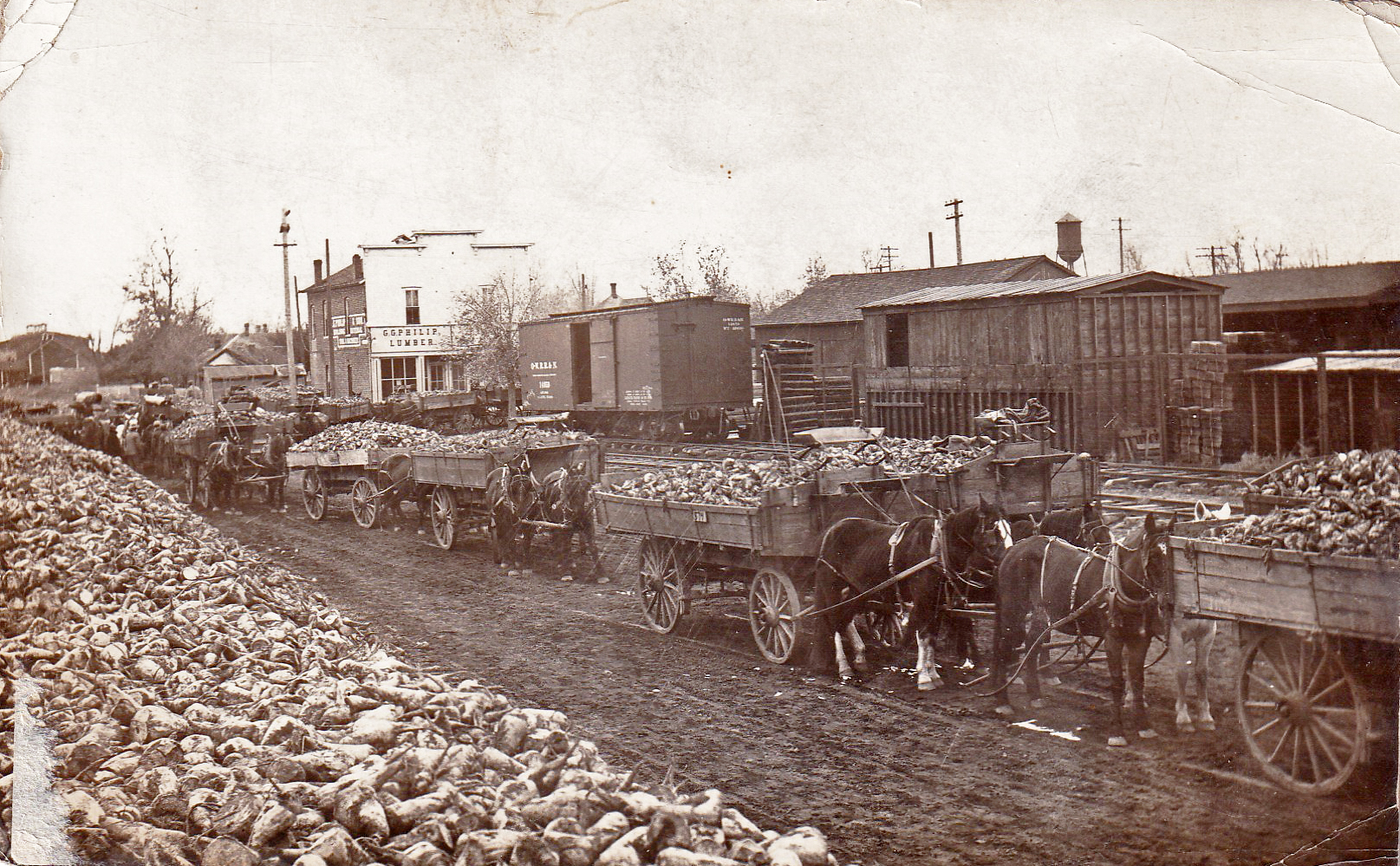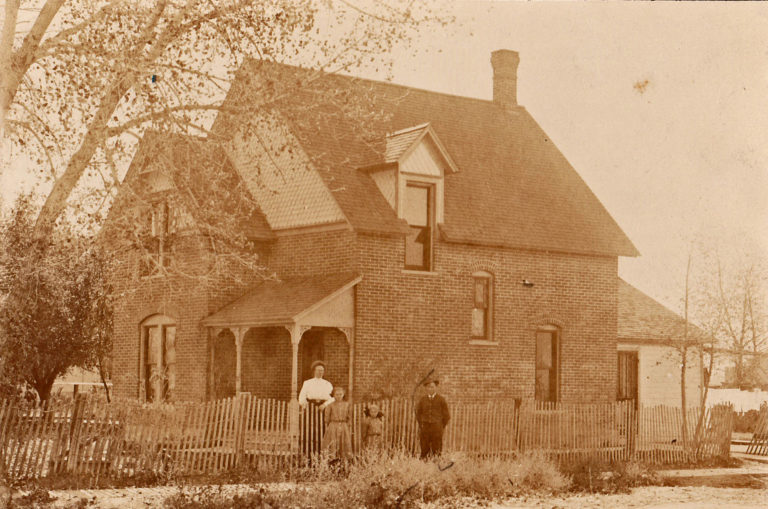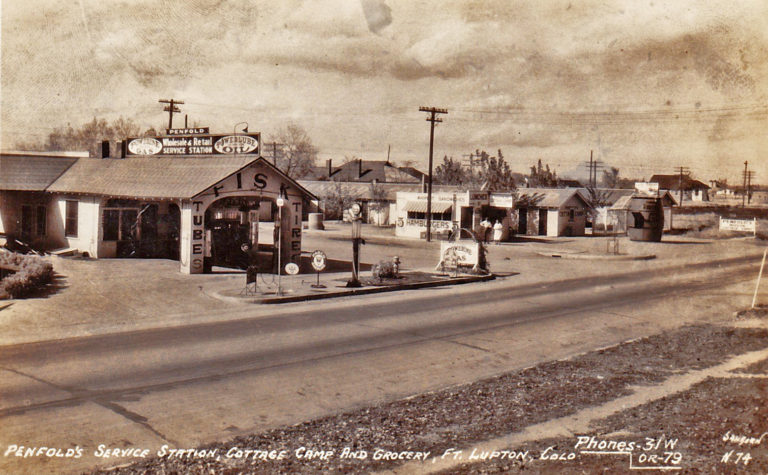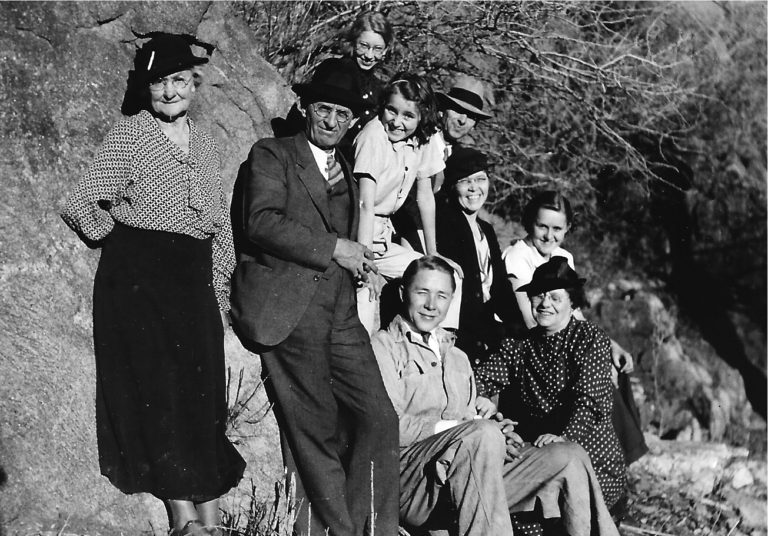What an abundance of sugar beets there is in this photo: the line-up of at least 10 fully-loaded wagons stretching back and around the corner in front of the G. G. Philip Lumber company and the big bank of sugar beets filling the lower-left corner of the photo. At first I thought the latter was a long pile of beets sitting on the ground, but realized it wouldn’t make much sense to first unload farmers’ beets onto the ground and then have to load them into rail cars. After doing some on-line research, I think what the camera is seeing are the tops of fully-loaded rail cars. To increase rail car capacity for sugar beets, railroads would add wooden extenders to the tops of the cars, including ones that jutted out at about a 30-degree angle from vertical. I’m thinking that, with the latter in place, the added volume of beets would tend to hide the gaps between cars if viewed from a fairly low angle. Here’s a link containing a picture taken in Wellington in 1910 of fully-loaded rail cars with extenders which displays that effect (it’s the third picture down): https://fortcollinsimages.wordpress.com/2016/11/06/the-sugar-beet-dump/ .
It’s interesting to note that none of the drivers are with their wagons. I assume this means they’re waiting for the railroad to provide empty cars. If you visually follow the right edge of the beets in the rail cars toward its intersection with the left border of the photo, you’ll see a group of people standing to the right. I bet those are the missing drivers, and they’re probably killing time — even back then people had to wait in lines!
Speaking of drivers, the sender of this postcard, who signs as MCB, had a connection with the team of horses closest to the camera. MCB’s message to Cora Black in Henderson postmarked April 19, 1914, reads: “Am still at Fort Lupton. Think I will go back to Denver this week. The team in the foreground is the outfit I ran last fall. So long.”
The wagons, each pulled by its own team of horses, are facing north, mostly likely in the direction of the apparatus which would load their beets into the rail cars. The apparatus was probably a Carroll beet dump, invented in 1894 by farmer and inventor Timothy Carroll of Anaheim, California. That year, Carroll had about a thousand tons of sugar beets that needed to be loaded onto a train at the Anaheim rail station, but he had tired of the cumbersome and slow beet dump process being used there at the time. He claimed the process was so slow it wasn’t unusual to see 30 loaded wagons parked by farmers overnight so as not to miss their turn the next day. The process required laying a net in the farmer’s wagon and fastening one side of it to the wagon before it was loaded with beets. Then, at the rail station, a derrick would grab the free end of the net and pull it up to a vertical position and spill the beets out onto an apron which fed the rail car. In the final analysis, Carroll decided to design his own beet dump, which proved very successful and consumed far less of the farmers’ time.
With the Carroll beet dump, the farmer would drive his wagon up a ramp until he reached a platform. Once on the platform, the wagon wheels would be locked and a hoist would raise one side of the wagon to dump the beets into a rail car. Since sugar factories paid by the pound, the wagon would first be weighed before starting up the ramp. During the dumping process, debris and dirt would fall through a metal grate (called a grizzly) into a hopper. After the wagon had emptied its load and come down the ramp on the other side, the contents of that hopper would be loaded back into the wagon, and the wagon would then be “weighed back,” i.e., re-weighed. The difference between the first and second weights would be that for which the farmer was paid.
Written testimonials from operators of Carroll beet dumps described a processing rate of about one wagon per minute. M. D. Whipple of the dump at the Johnson siding in Berthoud claimed that “we often started three teams up the dump and dumped the head ones (the first two) without stopping the third team till it stopped on the platform.”
Regarding the G. G. Philip Lumber company, I think it probably faced onto First Street, or what is now Highway 52. I base this on the relative locations in the photo of the store and the water tower. I remember that the water tower stood in the park just south of Highway 52.
The company was owned by George Gilfillan Philip. Born in Dundee, Scotland, in 1846, he married fellow Scot Annie Durie Smith of Kennoway in 1871, whom he called the “Rose of Kennoway.” Their honeymoon trip was their emigration to America. They made their way to Colorado, and in about 1872 George became a mine superintendent at Salina, a gold- and silver-mining town that sat about 7 miles west of Boulder. It was located at what is now the junction of Four Mile Canyon and Gold Run roads.
In 1887, the Philip family moved to Fort Lupton, and in that same year Annie gave birth to their fifth child, a daughter named Lonie. Their other four children were William (who died at age 18 in 1891), Smith, Cecil, and Bluebell. George reportedly wanted to move away from Salina to get his sons away from mining. As a mine superintendent he would have been well acquainted with the dangers of that work. In addition to establishing his lumber business, he was known as a successful and enterprising business man and farmer in the area. He was president of Lupton’s Philip & Allsebrook Hardware Company and a stockholder in the Fort Lupton State Bank. He involved his sons Smith and Cecil in his lumber business.
G. G. Philip was a strict prohibitionist. After E.R. Bringe and Henry Lambrecht opened separate billiards halls with saloons in 1891, G. G. Philip, Edgar St John and other Lupton citizens opposed their opening but were unsuccessful in getting them closed. In 1894, though, with the organization of the Fort Lupton chapter of the Women’s Christian Temperance Union, Lupton went “dry. ” I haven’t been able to determine how long Fort Lupton stayed dry, but it’s possible it did so from 1894 until the end of Prohibition in 1933. If you’d like to see a picture of G.G. Philip, here’s a link: https://www.findagrave.com/memorial/57254977/george-gilfillan-philip .
Not all of the Philip children lived out their lives in Fort Lupton. However their remains, those of all but one of their spouses, and those of their parents are all interred at Fort Lupton’s Hillside Cemetery.
REFERENCES:
- Annie Smith in Scotland, Select Marriages, 1561-1910, www.ancestry.com at https://www.ancestry.com/discoveryui-content/view/3142343:60144
- “Carroll Beet Dump in West Anaheim,” Calisphere, University of California, at https://calisphere.org/item/ark:/13030/kt958020d1/
- “The Carroll Dumping Apparatus – The Best Now in Use,” The Weekly Courier (Fort Collins), dated May 20, 1903, Colorado Historic Newspapers Collection at https://www.coloradohistoricnewspapers.org/cgi-bin/colorado?a=d&d=TWC19030520.2.51&e=——-en-20–1–img-txIN%7ctxCO%7ctxTA——–0——
- “The…Carroll Dump,” Internet Archive at https://archive.org/details/carrolldumpfordu00carrrich/page/n7/mode/2up
- “Crossroads in Eden: Development of Fort Lupton, 1835 – 2000,” by Adam Thomas, October 2003, at https://www.fortlupton.org/DocumentCenter/View/398/Crossroads-to-Eden?bidId=
- “G. G. Philip,” The Greeley Tribune, October 15, 1896, Colorado Historic Newspapers Collection at https://www.coloradohistoricnewspapers.org/?a=d&d=TGT18961015.2.58&srpos=1&e=——-en-20–1–img-txIN%7ctxCO%7ctxTA-g+g+philip+lumber+fort+lupton——-0——
- “GEORGE GILFILLAN PHILIP,” History of Colorado, Vol. 2, by Wilbur Fiske Stone at https://www.ebooksread.com/authors-eng/wilbur-fiske-stone/history-of-colorado-volume-2-not/page-79-history-of-colorado-volume-2-not.shtml
- Jessica Family Tree, www.ancestry.com
- “Prohibition,” www.Wikipedia.org at https://en.wikipedia.org/wiki/Prohibition#:~:text=Prohibition%20is%20the%20act%20or,and%20consumption%20of%20alcoholic%20beverages.
- -“Salina, Colorado” Western Mining History at https://westernmininghistory.com/towns/colorado/salina/
- “Salina, Colorado,” Wikipedia.org at https://en.wikipedia.org/wiki/Salina,_Colorado
- “The Sugar Beet Dump,” posted November 6, 2016, Fort Collins Images at https://fortcollinsimages.wordpress.com/2016/11/06/the-sugar-beet-dump/
- 1880 Census at www.ancestry.com




